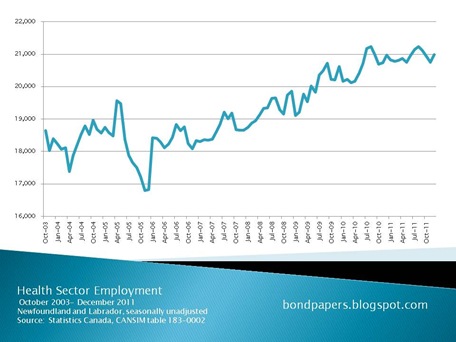last week’s release of the latest labour force numbers from Statistics Canada prompted your humble e-scribbler to go back and try a comparison of the overall provincial labour force in comparison to national averages.
Right off the bat, let everyone understand this is nothing more than a quick comparison based on readily available information. It should serve as the jumping off point for future discussion and if nothing else, it should help everyone get way beyond the rather simplistic comparisons of month-to-month numbers. Sometimes those things are meaningful but as the past couple of months have shown, sometimes, the statistics are just off.
The provincial numbers comes from a document included with the last provincial budget. It’s called The Economy and gives an overview of the year just ended. The national numbers come from the latest labour force statistics. Both sources use the same job classification system. The listing below bundles them together so that the comparisons match up.
The figures are the percentage of the total number of jobs in each category. For example, 1.7% of jobs in Canada are classified as being agricultural. The corresponding percentage for Newfoundland and Labrador is 0.4%
To draw attention to aspects of the comparison, please note that categories where the provincial percentage lags behind the national significantly are marked with the digits underlined. Where the provincial is significantly above the national average, the figures are in red.
Statisticians may wonder what the definition of “significant” is. Well, it comes down to the relative difference in the two numbers as they appear on the face of it.
Category | | |
| Goods-producing | 22% | 21% |
| Agriculture | 1.7 | 0.4 |
| Natural Res | 2.0 | 6.7 |
| Utilities | <1 | 2.1 |
| Construction | 7.0 | 7.3 |
| Manufacturing | 10.2 | 5.5 |
| | | |
| Services-producing | 78 | 79 |
| Trade | 15.7 | 16.2 |
| Trans/warehouse | 4.7 | 5.4 |
| Fin, ins, RE,Bus | 10.5 | 6.7 |
| Prof./sci./tech. | 7.4 | 3.6 |
| Education | 7.2 | 8.1 |
| Health/soc asst | 11.9 | 16.1 |
| Accn | 6.0 | 6.1 |
| Public Admin | 5.5 | 7.9 |
| Other | 4.3 | 4.8 |
Right off the bat, note that the relative breakdown into goods-producing and service- producing is virtually the same for both the provincial and national economies.
Let’s look at the goods sector. Overall, the provincial economy in this sector is very heavily reliant on resource extraction. The natural resources grouping (which includes fishing, trapping, mining and oil extraction) accounts for three times as large a percentage of jobs within the province as the same grouping. Manufacturing, on the other hand, accounts for only half as much. That 5.5% manufacturing for the province includes 2.2% for fish processing.
In the services sector, there are some equally interesting comparisons. Finance, insurance, real estate and business services account for 6.7% of the jobs in this province while the same grouping accounts for 105% of jobs nationally. The professional, scientific and technical services sector accounts for 3.6% of local jobs versus 7.4% nationally.
Take a look, though, at two service sectors which are publicly funded. About 16% of local jobs are in the health sector compared to 11.9% nationally; that’s 33% above the national number. Public administration is 43%, accounting for 7.9% of provincial jobs compared to 5.5% nationally.
Fully a quarter of the jobs in the province are public sector jobs compared to 17.4% of jobs across the country. Given that some of the other categories likely also contain public sector employees, it wouldn’t take too much to estimate reasonably that the public sector accounts for about one third of all workers in the province.
Incidentally, just to put actual numbers on this, the health and social assistance sector accounted for 34,600 jobs in 2009 according to the provincial government figures. That’s out of a total of 214,900 jobs. It is the single largest category in the service sector, with retail trade coming in at 29,600 for second place There were 17,300 in educational services and 16,900 people working in public administration.
The largest job category in goods-producing was construction at 15,700. The second largest was manufacturing with 11,900. Of that manufacturing number, 4,700 were involved in fish processing.
- srbp -
Pre-publication post-script update: This posts was written the night before it appeared. labradore has a simple set of numbers using more recent data for the size of the public sector in the province. His estimates are for the provincial public sector alone; the figures above are for federal, provincial and municipal.
Still, according to labradore, the provincial government public sector accounted for 25% of the current labour force in the first half of 2010.



